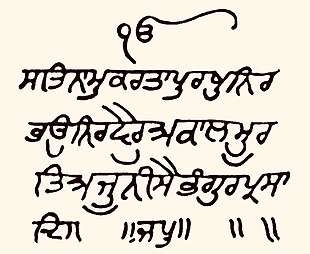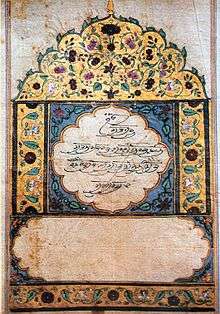Mul Mantar
Mūl Mantar (Punjabi: ਮੂਲ ਮੰਤਰ, IPA: [muːlᵊ mən̪t̪əɾᵊ]) are the opening words of the Sikh scripture, the Guru Granth Sahib. It consists of twelve words in the Punjabi language, written in Gurmukhi script, and are the most widely known among the Sikhs.[1][2] They summarize the essential teaching of Guru Nanak.[1] The Mul Mantar is a succinct doctrinal statement of Sikhism.[3]

| Part of a series on |
| Sikh scriptures |
|---|
 |
| Guru Granth Sahib |
| Dasam Granth |
|
| Sarbloh Granth |
| Varan Bhai Gurdas |
The Mul Mantar has been variously translated, with the interpretation of the first two words particularly contested.[4] These are rendered as "There is one god", "One reality is", "This being is one" and others. Sometimes the disagreements include capitalizing g in god, or r in reality, which affects the implied meaning in English.[1] Some consider it monotheistic, others monist. The general view favors the monotheistic interpretation, but not the Semitic understanding of monotheism. It is rather "Guru Nanak's mystical awareness of the one that is expressed through the many."[1] The remaining ten words after the first two are literally translated as true name, the creator, without fear, without hate, timeless in form, beyond birth, self-existent, (known by) the grace of Guru.[1][4]
The Mul Mantar is repeated in the Sikh scripture before numerous Shabad, or hymns.[5] It existed in many versions in the 16th-century before it was given its final form by Guru Arjan in the 17th century.[6] The essential elements of the Mantar are found in Guru Nanak's compositions, the various epithets he used for Akal Purakh (Ultimate Reality).
Etymology
A Mantar means "formula, succinct doctrinal or sacred words with spiritual meaning".[7][8] The word mūl means "root, main or "fundamental." The Mul Mantar is thus "root formula",[7] a succinct spiritual statement,[3] or the root statement of Sikhism.[1]
Text
The Mul Mantar is:[4]
| Gurmukhi | Transliteration | Translation 1 (Eleanor Nesbitt)[1] |
Translation 2 (Eleanor Nesbitt)[9] |
Translation 3 (Pashaura Singh)[10] |
|---|---|---|---|---|
|
ਸਤਿ ਨਾਮੁ ਕਰਤਾ ਪੁਰਖੁ ਨਿਰਭਉ ਨਿਰਵੈਰੁ ਅਕਾਲ ਮੂਰਤਿ ਅਜੂਨੀ ਸੈਭੰ ਗੁਰ ਪ੍ਰਸਾਦਿ॥ |
sat(i)-nām(u) kartā purakh(u) nirpà'u nirver(u) akāl mūrat(i) ajūnī sepàŋ gur-prasād(i)॥ |
truth by name, the creator, without fear, without hate, timeless in form, beyond birth, self-existent, (known by) the grace of the Guru. |
truth by name, creator, fearless, without hatred, of timeless form, unborn, self-existent, and known by the Guru's grace. |
the eternal reality (true name), the creator, without fear, devoid of enmity, immortal, never incarnated, self-existent, (known by) the grace of the Guru. |
The included grave accent in the transliteration illustrates tones and guide the verbal pronunciation of the verse. The small letters in the transliteration above, denoting short vowels, are not etymologically part of the word they are added to, but are included in the Guru Granth Sahib for vocalization purposes.
Translation

The Mul Mantar is a widely known part of Sikh scripture, but it has posed a challenge to translators.[1] The first two words Ik Onkar has been rendered multiple ways. It has been translated as "'There is one god', as 'One reality is', 'there is one God',[11] 'singularity despite seeming plurality,'[12] and 'This being is one,' and asserts the "distinctively Sikh theological emphasis" on "the ineffable quality of God" as "the Person beyond time," "the Eternal One," and "the One without form," and is canonically understood in Sikhism to refer to "absolute monotheistic unity of God".[13] The varying capitalization of "God", "Reality", or "Being" affects the meaning in English.[1] A number of translations erroneously change the Mul Mantar from a list of qualities to a statement of facts and possessive adjectives. For example, they may change Satnam from "truth by name" to "His name is truth", which adds a masculine quality to the Mul Mantar which does not appear in the original Gurmukhi. These sacred words of Sikhism do not presume a particular gender.[1] the Mūl Mantar serves as a "succinct statement which set the Sikh doctrine apart from the philosophical systems of both Indic and Semitic religious traditions."[3]

Some Sikh institutions, like the SGPC, consider the Mūl Mantar proper to end at "gur prasad," arguing that what follows is the name and first line of the Japji Sahib composition, citing the number of times that the verse appears as such preceding Gurbani compositions. On the other hand, other historic institutions, like some taksals (traditional Sikh religious educational institutions) and gurmat schools, hold the Mūl Mantar to be the full following verse, claiming that the Mūl Mantar in this form has been used in the Amrit Sanchar baptizing ceremony since its inception.[14] This is in line with the stand taken by the nihangs and other groups who stress the recitation of the complete Mul Mantar, arguing that this tradition has come directly from the time of the Gurus, and there is reliable evidence to support this contention;[14] like the kamar kassa, or waist-belt body armor of Guru Gobind Singh, preserved at Moti Bagh Palace Museum in Patiala, containing the inscription of the long Mul Mantar.[14]
The extended version with the Jap verse is:[15][16][17]
| Gurmukhi | Transliteration | Translation |
|---|---|---|
ਕਰਤਾ ਪੁਰਖੁ ॥ ਜਪੁ॥ ਆਦਿ ਸਚੁ |
kartā purakh(u) ॥ jap(u)॥ |
agentive (doer) being, Recite: |
References
- Eleanor Nesbitt, "Sikhism: a very short introduction", ISBN 0-19-280601-7, Oxford University Press, pp. 22-24
- Pashaura Singh (2000). The Guru Granth Sahib: Canon, Meaning and Authority. Oxford University Press. pp. 88–89. ISBN 978-0-19-564894-2.
- Pashaura Singh (2006). Life and Work of Guru Arjan: History, Memory, and Biography in the Sikh Tradition. Oxford University Press. p. 246. ISBN 978-0-19-567921-2.
- Pashaura Singh (2006). Life and Work of Guru Arjan: History, Memory, and Biography in the Sikh Tradition. Oxford University Press. pp. 245–258. ISBN 978-0-19-567921-2.
- Kalsi, Sewa Singh; Marty, Martin E. (March 2005). Sikhism. Chelsea House Publishers. p. 47. ISBN 978-0-7910-8356-7. Retrieved 17 July 2010.
- Pashaura Singh (2000). The Guru Granth Sahib: Canon, Meaning and Authority. Oxford University Press. pp. 88–89, earlier versions of Mul Mantar and context: 82–90. ISBN 978-0-19-564894-2.
- Pashaura Singh (2000). The Guru Granth Sahib: Canon, Meaning and Authority. Oxford University Press. p. 84. ISBN 978-0-19-564894-2.
- Jan Gonda (1963), The Indian Mantra, Oriens, Volume 16, pages 244–247
- Nesbitt, Eleanor (2018), "Sikhism", The International Encyclopedia of Anthropology, Oxford, UK: Wiley Blackwell, pp. 1–12, doi:10.1002/9781118924396.wbiea2186, ISBN 978-0-470-65722-5
- Pashaura Singh (2000). The Guru Granth Sahib: Canon, Meaning and Authority. Oxford University Press. pp. 85–89 (the final version: 88–89). ISBN 978-0-19-564894-2.
- Singh, Khushwant (2002). "The Sikhs". In Kitagawa, Joseph Mitsuo (ed.). The religious traditions of Asia: religion, history, and culture. London: Routledge. p. 114. ISBN 0-7007-1762-5.
- Singh, Wazir (1969). Aspects of Guru Nanak's philosophy. Routledge. p. 20.
- Doniger, Wendy (1999). Merriam-Webster's encyclopedia of world religions. Merriam-Webster. p. 500. ISBN 978-0-87779-044-0.
- Singh, Pashaura, Michael Hawley (2012). Re-imagining South Asian Religions: Essays in Honour of Professors Harold G. Coward and Ronald W. Neufeldt. BRILL. p. 39. ISBN 9789004242371.
- Rahi, Hakim Singh (1999). Sri Guru Granth Sahib Discovered: A Reference Book of Quotations from the Adi Granth. Delhi, India: Motilal Banarsidass Publishers. p. 8. ISBN 9788120816138. Retrieved 11 December 2019.
- Chauhan, G. S. (2005). Sri Guru Nanak Dev's Japji. New Delhi, India: Hemkunt Press. pp. 44–51. ISBN 9788170103141. Retrieved 11 December 2019.
- Beck, Guy (2006). Sacred Sound: Experiencing Music in World Religions. Waterloo, Canada: Wilfrid Laurier University Press. pp. 146–147. ISBN 9780889204218. Retrieved 11 December 2019.
Further reading
- Macauliffe, M.A (1909). The Sikh Religion: Its Gurus Sacred Writings and Authors. Low Price Publications. ISBN 81-7536-132-8.
- Shackle, C (1981). A Guru Nanak Glossary. School of Oriental and African Studies. ISBN 0-7286-0243-1.
- Singh, Dalip (1999). Sikhism in the Words of the Guru. Lok Sahit Prakashan. ASIN B0000CPD3S.
- Singh, Dr. Gopal (1962). Guru-Granth Sahib Vol.1. Taplinger Publishing Co.
- Singh, Dr. Santokh (1990). English Transliteration and Interpretation of Nitnaym Baanees, Sikh Prayers for English Speaking Sikh Youth. Sikh Resource Centre. ISBN 1-895471-08-7.
- Osho (1994). The True Name, Vol.1 : Discourses on Japji Sahib of Guru Nanak Dev. New Age International(P) Ltd. ISBN 81-224-0606-8.
- Dr Sahib Singh, D Lit (January 1972). Shiri Guru Granth Sahib Darpan. Raj Publishers (Regd), Adda Husharpur Jallundhar.
External links
- Mool Mantar, Damdami Taksaal
- English and Hindi translations
- Translation of Sri Guru Granth Sahib in >52 languages Machine translation of SGGS can be read from linked site by choosing appropriate language in transliterate and translation fields